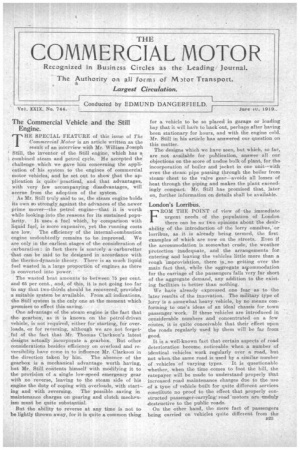The Commercial Vehicle and the Still Engine.
Page 1

If you've noticed an error in this article please click here to report it so we can fix it.
THE SPECIAL FEATURE of this issue of The Commercial Motor is an article written as the
• result of an interview with Mr. William Joseph
2 Still, the inventor of the Still engine, which has a combined steam and petrol cycle. He accepted the
challenge which we gave him concerning the application of his system to the engines of commercial motor vehicles, and he set out to show that the application is quite practical, and that advantages, with very few accompanying disadvantages, will accrue from the adoption of the system.
Aa Mr. Still truly said to us, the steam engine holds its own so strongly against the advances of the newer prime mover—the petrol engine—that it is worth while looking into the reasons for its sustained popularity. It uses a fuel which, by comparison with liquid fad, iu more expensive, yet the running costs are low. The efficiency of the internal-combustion engine undoubtedly remains to be improved. We are only in the earliest stages of the consideration of carburation: in fact there is scarcely a carburetter that can be said to be .designed in accordance with the thermo-dynamic theory. There is as much liquid fuel wasted in a large proportion of engines as there is converted into power. '
The wasted heat amo.unts'to between 75 per cent. and 65 per cent., and, of this, it is not going too far to say that two-thirds should be. recovered, provided a suitable system be available. From all indications, the Still system is the only one at the moment which promises to effect this saving.
One advantage of thefl steam engine is the fact that the gearbox, as it is known on the petrol-driven vehicle, is not required, either for starting, foi overloads, or for reversing, although we are hot forget-fill of the fact that Mr. Thomas Clarkson's latest designs actually incorporate a gearbox. But other considerations besides efficiency on overload and reversibility have come in to influence Mr. Clarkson in the direction taken by him. The absence of the gearbox is a mechanical advantage worth having, but Mr. Still contents himself with modifying it to the provision of a single low-speed emergency gear with no reverse, leaving to the steam side of his engine the duty of coping with overloads, with starting and with reversing. The possible saving in maintenance charges on gearing and clutch mechauism must be quite substantial. • . But the ability to reverse at any time is not to be lightly thrown away, for it is quite a common thing
for a vehicle to be so placed in garage or loading bay that it will have to back out, perhaps after having been stationary for hours, and with the engine cold. Kr. Still in his article has answered our question on this matter.
The designs which we have seen, but which, so far, are not available for publication, answer all our objections on the score of undue bulk of plant, for the incorporation of boiler and jacket in one unit—with even the steam pipe passing through the boiler from steam chest to the valve gear—avoids all losses of heat through the piping and makes the plant exceedingly compact. Mr. Still has promised that, later on, further information on details shall be available.
























